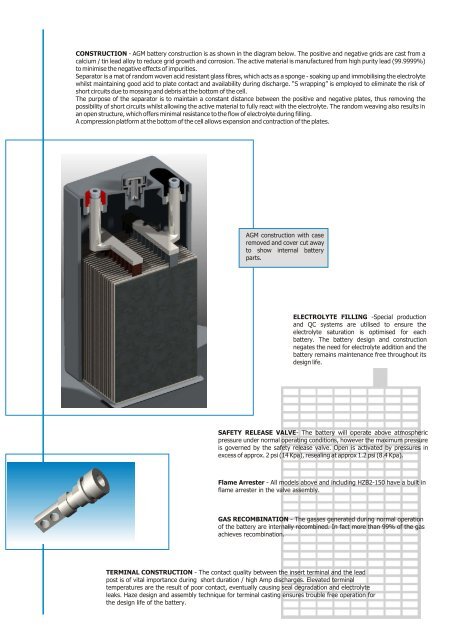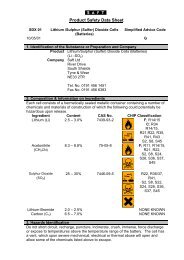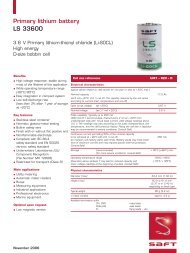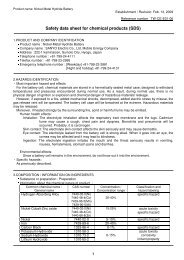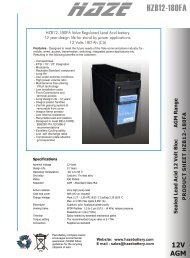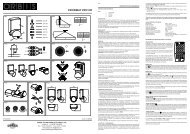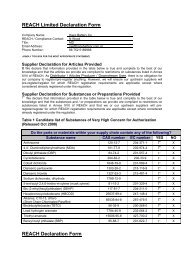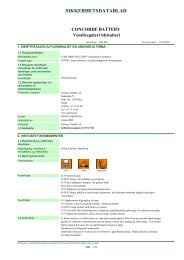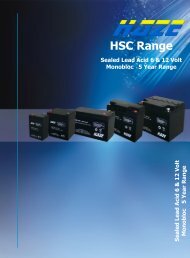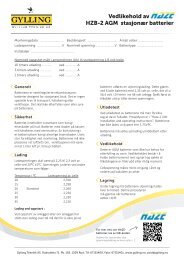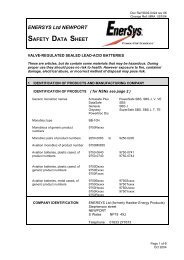2V bloc AGM 1512081.pdf
2V bloc AGM 1512081.pdf
2V bloc AGM 1512081.pdf
You also want an ePaper? Increase the reach of your titles
YUMPU automatically turns print PDFs into web optimized ePapers that Google loves.
CONSTRUCTION - <strong>AGM</strong> battery construction is as shown in the diagram below. The positive and negative grids are cast from a<br />
calcium / tin lead alloy to reduce grid growth and corrosion. The active material is manufactured from high purity lead (99.9999%)<br />
to minimise the negative effects of impurities.<br />
Separator is a mat of random woven acid resistant glass fibres, which acts as a sponge - soaking up and immobilising the electrolyte<br />
whilst maintaining good acid to plate contact and availability during discharge. “S wrapping” is employed to eliminate the risk of<br />
short circuits due to mossing and debris at the bottom of the cell.<br />
The purpose of the separator is to maintain a constant distance between the positive and negative plates, thus removing the<br />
possibility of short circuits whilst allowing the active material to fully react with the electrolyte. The random weaving also results in<br />
an open structure, which offers minimal resistance to the flow of electrolyte during filling.<br />
A compression platform at the bottom of the cell allows expansion and contraction of the plates.<br />
<strong>AGM</strong> construction with case<br />
removed and cover cut away<br />
to show internal battery<br />
parts.<br />
ELECTROLYTE FILLING -Special production<br />
and QC systems are utilised to ensure the<br />
electrolyte saturation is optimised for each<br />
battery. The battery design and construction<br />
negates the need for electrolyte addition and the<br />
battery remains maintenance free throughout its<br />
design life.<br />
SAFETY RELEASE VALVE- The battery will operate above atmospheric<br />
pressure under normal operating conditions, however the maximum pressure<br />
is governed by the safety release valve. Open is activated by pressures in<br />
excess of approx. 2 psi (14 Kpa), resealing at approx 1.2 psi (8.4 Kpa).<br />
Flame Arrester - All models above and including HZB2-150 have a built in<br />
flame arrester in the valve assembly.<br />
GAS RECOMBINATION - The gasses generated during normal operation<br />
of the battery are internally recombined. In fact more than 99% of the gas<br />
achieves recombination.<br />
TERMINAL CONSTRUCTION - The contact quality between the insert terminal and the lead<br />
post is of vital importance during short duration / high Amp discharges. Elevated terminal<br />
temperatures are the result of poor contact, eventually causing seal degradation and electrolyte<br />
leaks. Haze design and assembly technique for terminal casting ensures trouble free operation for<br />
the design life of the battery.


